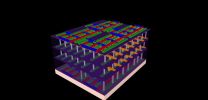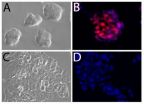Control on shape of light particles opens the way to 'quantum internet'
Researchers TU/e and FOM obtain vital control on the emission of photons
2014-12-15
(Press-News.org) In the same way as we now connect computers in networks through optical signals, it could also be possible to connect future quantum computers in a 'quantum internet'. The optical signals would then consist of individual light particles or photons. One prerequisite for a working quantum internet is control of the shape of these photons. Researchers at Eindhoven University of Technology (TU/e) and the FOM foundation have now succeeded for the first time in getting this control within the required short time. These findings are published today in Nature Communications.
Quantum computers are the dream computers of the future. They use the unique physics of the smallest particles- those described by quantum mechanics - to perform calculations. While today's computers use bits that can be either 0 or 1, quantum computers perform calculations with 'qubits', which can be both 0 and 1 at the same time. That creates an unprecedented degree of extra computing power, which gives quantum computers much greater capabilities than today's computers.
Quantum internet
Quantum computers could in principle communicate with each other by exchanging individual photons to create a 'quantum internet'. The shape of the photons, in other words how their energy is distributed over time, is vital for successful transmission of information. This shape must be symmetric in time, while photons that are emitted by atoms normally have an asymmetric shape. Therefore, this process requires external control in order to create a quantum internet.
Optical cavity
Researchers at TU/e and FOM have succeeded in getting the required degree of control by embedding a quantum dot - a piece of semiconductor material that can transmit photons - into a 'photonic crystal', thereby creating an optical cavity. Then the researchers applied a very short electrical pulse to the cavity, which influences how the quantum dot interacts with it, and how the photon is emitted. By varying the strength of this pulse, they were able to control the shape of the transmitted photons.
Within a billionth of a second
The Eindhoven researchers are the first to achieve this, thanks to the use of electrical pulses shorter than nanosecond, a billionth of a second. This is vital for use in quantum communication, as research leader Andrea Fiore of TU/e explains: "The emission of a photon only lasts for one nanosecond, so if you want to change anything you have to do it within that time. It's like the shutter of a high-speed camera, which has to be very short if you want to capture something that changes very fast in an image. By controlling the speed at which you send a photon, you can in principle achieve very efficient exchange of photons, which is important for the future quantum internet."
INFORMATION:
References
Francesco Pagliano et al, Dynamically controlling the emission of single excitons in photonic crystal cavities, Nature Communications (15 December 2014)
DOI: 10.1038/ncomm6786
The research is financed by the FOM Foundation and Technology Foundation STW.
ELSE PRESS RELEASES FROM THIS DATE:
2014-12-15
For decades, the mantra of electronics has been smaller, faster, cheaper.
Today, Stanford engineers add a fourth word - taller.
At a conference in San Francisco, a Stanford team will reveal how to build high-rise chips that could leapfrog the performance of the single-story logic and memory chips on today's circuit cards.
Those circuit cards are like busy cities in which logic chips compute and memory chips store data. But when the computer gets busy, the wires connecting logic and memory can get jammed.
The Stanford approach would end these jams by building layers ...
2014-12-15
PEOPLE who have problems with numbers may be more likely to feel negative about bowel cancer screening, including fearing an abnormal result, while some think the test is disgusting or embarrassing, according to a Cancer Research UK supported study* published today (Monday) in the Journal of Health Psychology.
The researchers** sent information about bowel cancer screening to patients aged from 45 to 59 along with a questionnaire which assessed their numerical skills and attitudes to the screening test, which looks for blood in stool samples.
Almost 965 people - registered ...
2014-12-15
E-cigarette use among teenagers is growing in the U.S., and Hawaii teens take up e-cigarette use at higher rates than their mainland counterparts, a new study by University of Hawaii Cancer Center researchers has found.
The findings come as e-cigarettes grow in popularity and the Food and Drug Administration is considering how to regulate their sale. Some public health officials are concerned that e-cigarettes may be recruiting a new generation of young cigarette smokers who otherwise might not take up smoking at all, and the study's results bolster this position.
Data ...
2014-12-15
While serious infections can be transmitted from donated organs, the risk of passing Ebola virus disease from an organ donor to a recipient is extremely small. In a new editorial published in the American Journal of Transplantation, experts explain how simple assessments of donors can help ensure that the organ supply is safe, while having little impact on the donor pool.
Despite screening all organ donors for infection, on rare occasions an organ donor will transmit an unexpected infection to a recipient. Because cases of Ebola virus disease have occurred in the United ...
2014-12-15
Both positive and negative experiences influence how genetic variants affect the brain and thereby behaviour, according to a new study. "Evidence is accumulating to show that the effects of variants of many genes that are common in the population depend on environmental factors. Further, these genetic variants affect each other," explained Sheilagh Hodgins of the University of Montreal and its affiliated Institut Universitaire en Santé Mentale de Montréal. "We conducted a study to determine whether juvenile offending was associated with interactions between three ...
2014-12-15
Baltimore MD-- We would not expect a baby to join a team or participate in social situations that require sophisticated communication. Yet, most developmental biologists have assumed that young cells, only recently born from stem cells and known as "progenitors," are already competent at inter-communication with other cells.
New research from Carnegie's Allan Spradling and postdoctoral fellow Ming-Chia Lee shows that infant cells have to go through a developmental process that involves specific genes before they can take part in the group interactions that underlie ...
2014-12-15
TORONTO, ON - Consider the relationship between an air traffic controller and a pilot. The pilot gets the passengers to their destination, but the air traffic controller decides when the plane can take off and when it must wait. The same relationship plays out at the cellular level in animals, including humans. A region of an animal's genome - the controller - directs when a particular gene - the pilot - can perform its prescribed function.
A new study by cell and systems biologists at the University of Toronto (U of T) investigating stem cells in mice shows, for the ...
2014-12-13
White adipose tissue stores excess calories as fat that can be released for use in other organs during fasting. Mammals also have small amounts of brown adipose tissue, which primarily acts as an effective fat burner for the production of heat. Now researchers from the University of Southern Denmark have uncovered the mechanism by which white fat cells from humans gets reprogrammed to become browner.
Browning of white adipose tissue increases the energy consumption of the body and therefore constitutes a potential strategy for future treatment of obesity. The challenge ...
2014-12-13
Immune cells perform a previously unsuspected role in the brain that may contribute to obesity, according to a new study by UC San Francisco researchers.
When the researchers fed mice a diet high in saturated milk fats, microglia, a type of immune cell, underwent a population explosion in the brain region called the hypothalamus, which is responsible for feeding behavior.
The researchers used an experimental drug and, alternatively, a genetic approach to knock out these microglia, and both strategies resulted in a complete loss of microglia-driven inflammation in the ...
2014-12-12
PHOENIX, Ariz. -- Dec. 12, 2014 -- Using a basic genetic difference between men and women, the Translational Genomics Research Institute (TGen) has uncovered a way to track down the source of a neurological disorder in a young girl.
TGen's discovery relies on a simple genetic fact: Men have one X and one Y chromosome, while women have two X chromosomes. This women-only factor was leveraged by TGen investigators to develop a highly accurate method of tracking down a previously unrecognized disorder of the X-chromosome.
The study of a pre-teen girl, who went years ...
LAST 30 PRESS RELEASES:
[Press-News.org] Control on shape of light particles opens the way to 'quantum internet'
Researchers TU/e and FOM obtain vital control on the emission of photons




